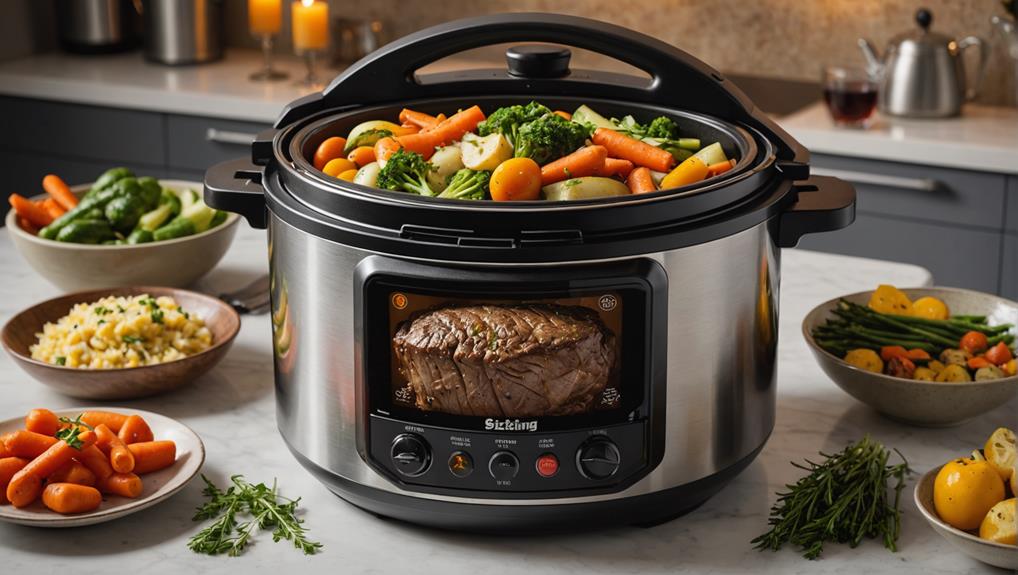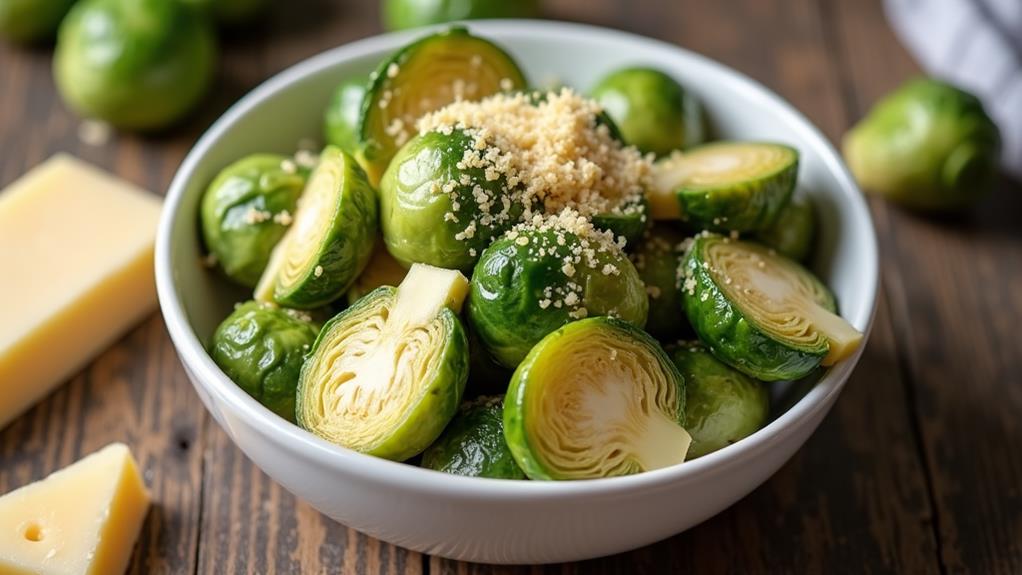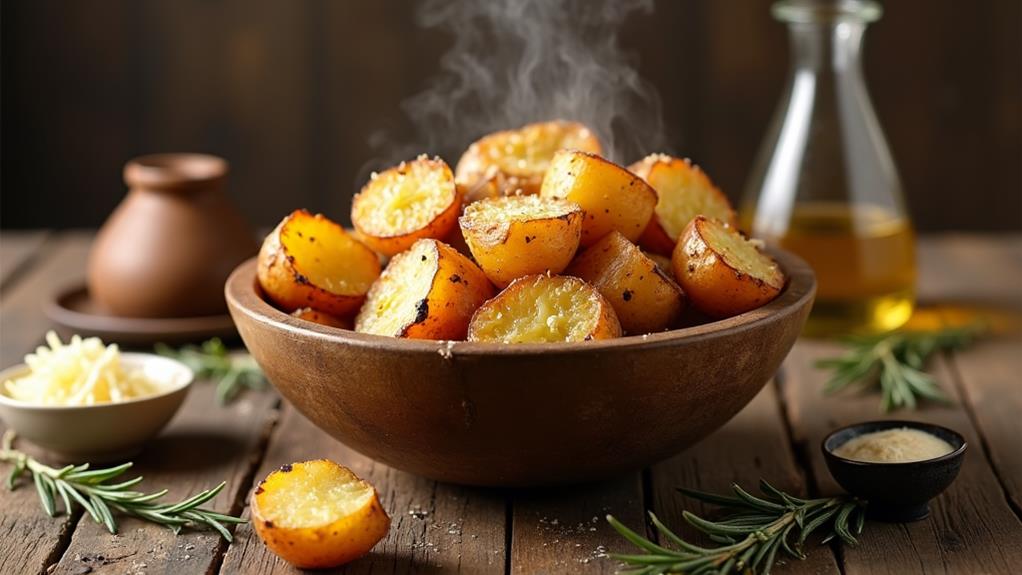Unlock the secrets of mouthwatering meat with pressure cooking. You'll transform tough cuts into tender delights in a fraction of the time. Choose well-marbled meats like pork shoulder or short ribs for best results. Enhance flavors through brining or seasoning rubs, allowing time for absorption. Sear your meat for a golden crust before pressure cooking to add depth. Create a flavorful liquid base with broth, aromatics, and spices to infuse your meat. Use natural release for tougher cuts to maximize tenderness. After cooking, let the meat rest, then reduce the cooking liquid for a rich sauce. These techniques will elevate your pressure-cooked meats to new levels of savory perfection.
Pressure Cooking Basics
Harnessing the power of steam and pressure, pressure cooking revolutionizes the way we prepare meals. This innovative technique significantly reduces cooking times, making it perfect for busy home chefs who want to create delicious dishes without spending hours in the kitchen.
By employing a method akin to braising meats, pressure cooking transforms tough cuts of meat into tender, succulent morsels more efficiently. At the heart of pressure cooking is the ability to raise the boiling point of water to approximately 250°F (121°C) by operating at a standard pressure of 15 PSI. This higher temperature ensures that your food cooks evenly and thoroughly, transforming tough cuts of meat into tender, succulent morsels.
To begin your pressure cooking journey, you'll need at least one cup of liquid to create steam and build pressure. Water, broth, or sauces can serve as your cooking medium.
The Instant Pot, a versatile pressure cooker, offers multiple functions beyond pressure cooking, including slow cooking, rice cooking, and even yogurt making. Modern pressure cookers come equipped with essential safety features like locking lids and pressure release valves, ensuring a secure cooking environment.
As you explore the world of pressure cooking, you'll discover its efficiency in tenderizing meats and creating flavorful meals in a fraction of the time.
Choosing the Perfect Cut
Now that you've grasped the basics of pressure cooking, let's focus on selecting the right meat for your dishes. The key to succulent, flavorful results lies in choosing well-marbled cuts with higher fat content. A Boston butt, weighing 4 to 7 pounds, is ideal for pressure cooking, ensuring moisture and rich flavor.
For innovative cooks seeking to elevate their pressure-cooked creations, consider these options:
- Pork shoulder: A versatile cut that breaks down beautifully under pressure
- Bone-in pork: Adds depth of flavor and enhances overall texture
- Short ribs: Perfect for braising, resulting in tender, fall-off-the-bone meat
- Chuck roast: Ideal for creating rich, hearty dishes with minimal effort
Avoid lean cuts like pork loin, which can dry out quickly. Instead, opt for cuts with ample connective tissue, such as brisket or specialty cuts like short ribs. These choices will yield tender, moist results and contribute to flavorful sauces.
Marination and Seasoning Secrets
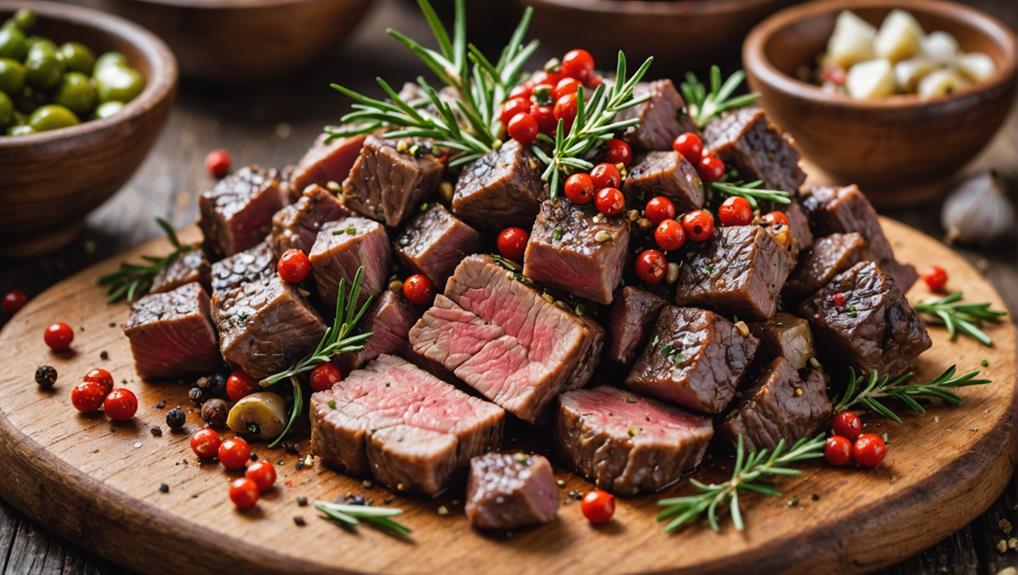
You'll unlock incredible flavors in your pressure-cooked meals by mastering the art of brining and dry rubs.
To create a perfect brine, combine salt, sugar, and water in proportions that complement your chosen meat, allowing it to soak for 12 to 36 hours for maximum flavor penetration.
For a dry rub masterclass, experiment with spices like cumin, garlic powder, and paprika, customizing your blend to suit your taste preferences and enhancing the meat's natural flavors.
Flavor-Enhancing Brine Techniques
For pressure cooking enthusiasts, mastering the art of brining is a game-changer. This flavor-enhancing technique involves soaking pork in a solution of water, salt, and brown sugar for 12 to 36 hours. A standard brine consists of 1/2 cup each of salt and brown sugar dissolved in 2 quarts of cold water.
This process not only enhances flavor absorption but also ensures moisture retention, resulting in a rich and succulent end product.
To maximize your brining success, consider these innovative tips:
- Choose well-marbled cuts like a 4 to 7-pound Boston butt for optimal tenderness
- Experiment with adding spices and herbs to your brine for unique flavor profiles
- Always rinse the pork after brining to prevent over-salting
- Avoid lean cuts like pork loin, as they're less suitable for brining
Dry Rub Masterclass
Mastering the art of dry rubs can elevate your pressure cooking game to new heights. In this dry rub masterclass, you'll discover the secrets to creating flavor-packed dishes that'll rival any slow cooking method.
Start with a well-balanced mix of spices like cumin, garlic powder, onion powder, and paprika. Don't be afraid to experiment with heat levels by adjusting cayenne or chili powder to suit your taste.
To maximize flavor absorption, apply your rub generously and let the meat rest for 12 to 24 hours before cooking. This crucial step ensures the spices penetrate deeply, infusing every bite with savory goodness.
For an extra touch of innovation, consider adding honey or sugar to your rub. These ingredients caramelize during cooking, creating a delectable crust and enhancing the overall sweetness of your dish.
Searing for Maximum Flavor
The art of searing is a crucial step in unlocking maximum flavor when pressure cooking. By employing high heat and a touch of oil, you'll create a golden-brown crust on your meat that not only traps juices but also develops complex taste profiles through the Maillard reaction. This process isn't just about flavor; it's about elevating your dish to new heights of culinary excellence.
To master the searing technique, follow these innovative tips:
- Sear in small batches to prevent overcrowding
- Use high heat for a perfect crust
- Deglaze the pot to capture every flavor-packed morsel
- Embrace the visual appeal of beautifully browned meat
As you sear, you're not just cooking; you're crafting a masterpiece. The contrast between the rich, caramelized exterior and the tender interior will tantalize taste buds and elevate your pressure-cooked meals.
Liquid and Aromatics Selection
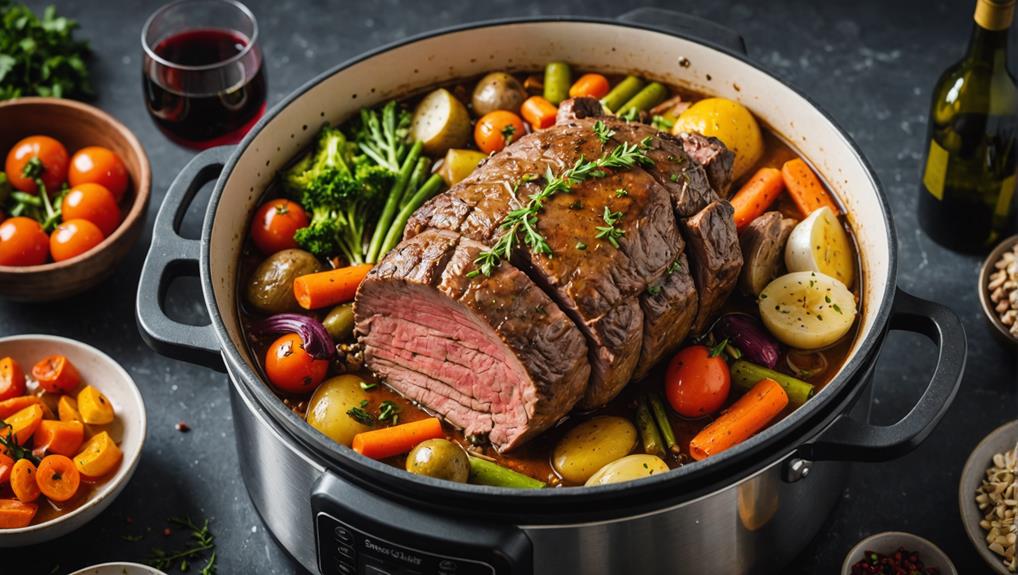
When selecting liquids for pressure cooking, you'll want to explore flavorful broth combinations that enhance your dish's richness and depth.
Start with a base of beef broth for meats, and consider adding complementary liquids like soy sauce or wine to introduce unique flavor profiles.
Don't forget to incorporate essential aromatic ingredients such as sliced onions, minced garlic, and herbs, which will infuse your meal with additional layers of taste during the cooking process.
Flavorful Broth Combinations
Creating a flavorful broth is the cornerstone of successful pressure cooking. To elevate your meat dishes, start with a base of 1/2 cup beef broth and enhance it with aromatics like sliced onions and minced garlic. This combination forms the foundation for a rich, savory liquid that'll infuse your meats with incredible taste.
For added substance, consider incorporating elements from classic dishes, such as those found in Slow Cooker Chili Con Carne to inspire your flavor profile.
To add depth and umami, incorporate soy sauce or Worcestershire sauce into your broth. These ingredients bring complexity to your pressure-cooked meals, complementing the natural flavors of the meat. For a spice boost, don't hesitate to include bay leaves, black pepper, and smoked paprika. These aromatics will infuse your dish with robust flavors during the cooking process.
Experiment with innovative broth combinations to create unique flavor profiles:
- Citrus-infused broth for a bright, zesty twist
- Herb-packed liquid for a fresh, aromatic experience
- Sweet and savory blend using ketchup and brown sugar
- Seasonal vegetable puree for a nutrient-rich base
Essential Aromatic Ingredients
Building on the foundation of flavorful broths, selecting the right combination of liquids and aromatics is key to unlocking the full potential of pressure-cooked meats.
You'll want to start with a robust base of beef broth, soy sauce, or cooking wine to infuse your dish with depth and moisture; for instance, using Hearty Beef Stew With Root Vegetables as a reference can guide your liquid selection. These liquids work in tandem with aromatic powerhouses like sliced onions, garlic, and ginger to create a symphony of flavors.
Don't overlook the importance of bay leaves and garlic powder in your aromatic arsenal. These ingredients, along with smoked paprika and black pepper, can elevate your meat's taste profile to new heights.
For a well-rounded flavor, consider incorporating a touch of sweetness with brown sugar or honey to balance the savory notes.
The key to pressure cooking success lies in your ability to combine these elements effectively. Experiment with different ratios and combinations to find your perfect flavor blend.
Cooking Times and Temperatures
Understanding the ins and outs of cooking times and temperatures is crucial for mastering pressure cooking. With the right knowledge, you'll transform tough cuts into tender delicacies in record time.
For perfect pork, the Instant Pot revolutionizes the cooking process. Braised pork belly, traditionally a 2-hour affair, now takes just 30 minutes under high pressure. You'll achieve tender brisket in an hour, with a 10-minute natural release for optimal texture.
For those aiming for innovation in their kitchen, here's why mastering pressure cooking is a game-changer:
- Dramatically reduced cooking times
- Enhanced flavor retention
- Consistent, reproducible results
- Energy-efficient meal preparation
While pressure cooking speeds things up, some cuts still benefit from traditional methods. Pulled pork, for instance, requires 10 to 16 hours at 225°F to reach its ideal 200°F internal temperature.
When brining Boston butt, aim for 12 to 36 hours, with 24 hours being the sweet spot for flavor infusion.
Natural Release Vs Quick Release
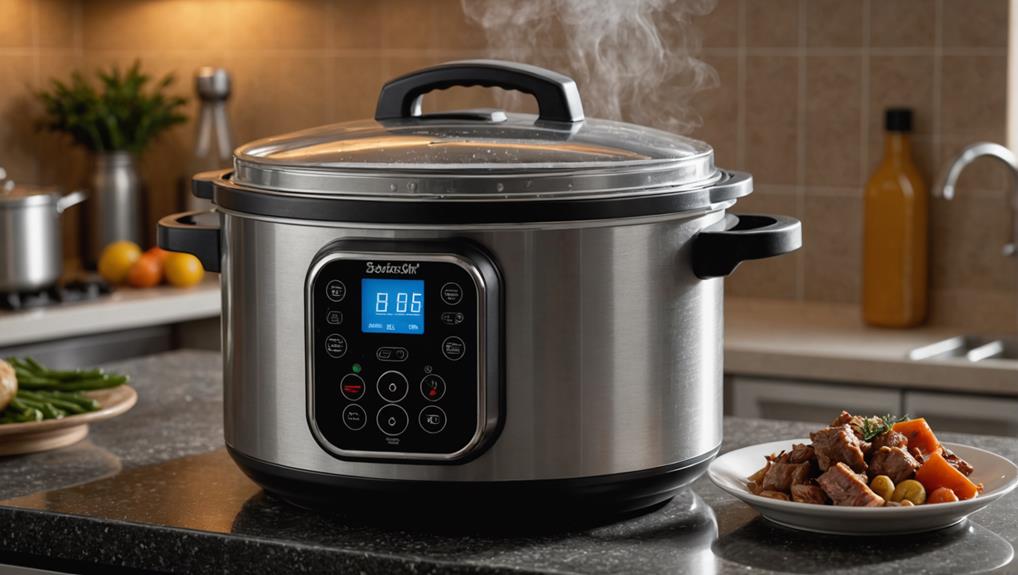
In pressure cooking, mastering the art of release is as crucial as perfecting cooking times. You'll encounter two primary methods: natural release and quick release. Each serves a distinct purpose in your culinary arsenal.
Natural release is your go-to technique for tenderizing that tough piece of meat. By allowing pressure to decrease gradually over 10 to 30 minutes, you're giving those flavorful juices time to redistribute throughout your dish.
This method works wonders for briskets and other stubborn cuts, transforming them into succulent masterpieces. It's also ideal for recipes featuring rich sauces or gravies, as it allows flavors to concentrate beautifully.
On the flip side, quick release is your ally when you're cooking delicate foods like vegetables or seafood. By manually releasing the steam immediately, you prevent overcooking and preserve texture.
It's a game-changer for maintaining that perfect al dente crunch in your veggies.
Tenderizing Tough Cuts
Pressure cooking shines brightest when it comes to tenderizing tough cuts of meat. You'll be amazed at how quickly you can transform a stubborn brisket or pork shoulder into a melt-in-your-mouth delicacy.
Unlike a slow cooker, which can take all day, your pressure cooker can have that same brisket fall-apart tender in about an hour. The magic lies in the high-pressure environment, which breaks down connective tissues and collagen, resulting in incredibly tender and flavorful dishes.
To maximize your pressure cooking prowess, consider these tips:
- Add flavor-enhancing ingredients like beef broth, onions, and spices
- Use the natural release method for extra tenderness
- Experiment with larger cuts, like a 4-7 pound Boston butt
- Don't be afraid to push boundaries and try new flavor combinations
Enhancing Flavors Post-Cooking
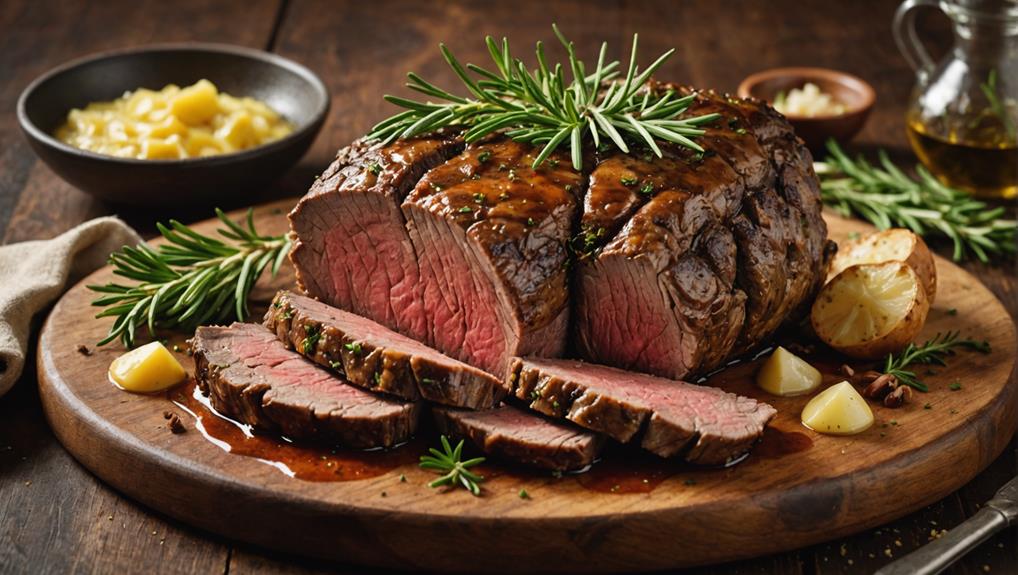
The magic of pressure cooking doesn't end when you release the steam. To truly elevate your dish, you'll want to focus on enhancing flavors post-cooking.
Start by allowing your meat to rest for 10-15 minutes, which helps retain its juices and amplify overall flavor. While it's resting, turn your attention to the cooking liquid. Straining the cooking liquid and skimming off excess fat will concentrate flavors, creating a richer sauce. Return this liquid to the pot and reduce it further for maximum impact.
Next, shred the cooked meat and mix it back into the reduced sauce. This technique ensures flavors meld uniformly throughout the dish.
Don't forget about seasoning post-cooking; this is your chance to fine-tune the taste to your liking. While aromatics and spices added during cooking provide a solid flavor foundation, additional seasoning now allows for personalized adjustments.
Frequently Asked Questions
What Is the Best Meat to Cook in a Pressure Cooker?
You'll get the best results with tougher cuts in your pressure cooker. Brisket, chuck roast, and pork shoulder are top choices. These best pressure cooker cuts transform under high pressure, tenderizing tough meats into succulent, flavorful dishes you'll love.
How Long Do You Cook 2 Lb of Meat in a Pressure Cooker?
You've cracked the code, genius! For tender cuts, cook 2 lbs of meat for 25-30 minutes on high pressure. Cooking times vary, so unleash your inner culinary innovator. Remember, natural release for 10 minutes seals the deal!
Does Meat Need to Be Submerged in a Pressure Cooker?
You don't need to submerge meat in a pressure cooker. For optimal meat tenderness, use innovative cooking techniques like browning first, then adding minimal liquid. Elevate the meat on a trivet to steam it, enhancing flavor and texture.
How Much Water Do I Put in a Pressure Cooker for Meat?
You're not drowning your meat, chef extraordinaire! For optimal meat tenderness, you'll want 1-1.5 cups of cooking liquid. But hey, let's innovate! Experiment with broths, wines, or even coconut milk to elevate your pressure cooking game.
Final Thoughts
You've now unlocked the secrets to pressure cooking mouthwatering meat dishes. By mastering these techniques, you'll be cooking with gas in no time. Remember to choose the right cut, marinate effectively, sear for flavor, and select complementary liquids and aromatics. Pay attention to cooking times, release methods, and post-cooking enhancements. With practice, you'll transform tough cuts into tender delights and create savory masterpieces that'll impress family and friends. Keep experimenting and refining your skills to elevate your pressure cooking game.

